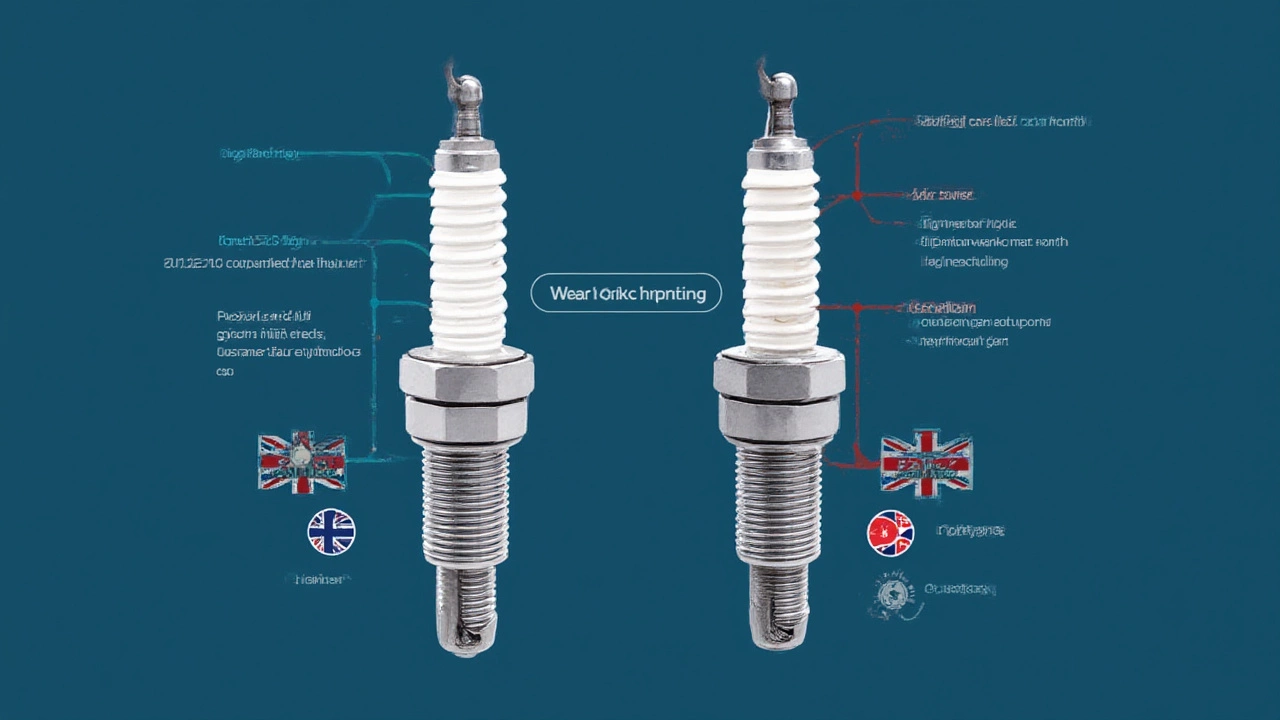If your car has been acting up lately, there's a good chance the culprit is hiding right under the hood—spark plugs. These tiny gadgets get almost zero love, but your engine depends on them every single time you turn the key. Forgetting about them is about as risky as sending your kid to school with no shoes. Dirty, worn, or faulty spark plugs can mess with your gas mileage, slow your acceleration, and even leave you stranded on the side of the road. Most people ignore them until something goes wrong, but catching problems early makes all the difference. You don’t need to be a mechanic to figure out if they’re on their last legs—all it takes is a bit of know-how and some sharp observation.
What Spark Plugs Actually Do (and Why They Go Bad)
Think of spark plugs as the little but powerful gatekeepers inside your engine. Every time your engine cycles, a spark plug creates a tiny bolt of lightning—it zaps a spark across a small gap, igniting the fuel and air mixture inside the cylinder. That mini-explosion is what sends your car flying down the street. Now multiply this process by thousands-of-times-per-minute, and it’s no wonder these guys wear out. Over time, the metal wears down, carbon builds up, and the gap widens. Even a top-notch spark plug can only handle so much before it starts misfiring, struggling to ignite, or failing altogether.
Spark plug life depends on what they’re made of. Standard copper plugs might last about 20,000–30,000 miles. Iridium and platinum versions stretch farther—sometimes past 60,000 or even 100,000 miles. But driving style matters: frequent short trips, stop-and-go city traffic, or cold starts put more strain on them. High-revving engines or poor maintenance (think skipped oil changes) can also shorten their lifespan. Many modern cars have long-life plugs but that doesn’t mean you can forget about them. If you ignore your spark plugs until the check engine light’s been glowing for months, you could wind up facing bigger, pricier engine repairs.
Fun fact: According to a 2023 AAA study, neglected spark plugs are responsible for about 16% of roadside break-downs related to engine starting issues. A simple plug check could keep you from calling for a tow truck. Let’s break down what actually happens when spark plugs start to fail—because the red flags aren't always what you expect.
Clear Signs Your Spark Plugs Are Crying for Help
Most cars won’t flash a “Replace Spark Plugs” light on the dashboard. Instead, you’ll notice small changes at first. One of the most obvious symptoms is rough idling. If your engine’s vibrating, the steering wheel’s shaking when you’re at a stoplight, or you hear odd stuttering noises, bad plugs could be to blame. Don’t brush it off. Misfires—those pops and drops in engine rhythm—happen when a plug can’t ignite the air/fuel mix properly. Your car might jerk under acceleration or hesitate when you hit the gas.
Another big clue is a dip in gas mileage. Have you found yourself filling up more often, even though your driving habits haven’t changed? Worn-out spark plugs aren’t efficient at burning fuel, so your engine has to work harder and guzzles more gas. Modern engines are super sensitive; even a tiny drop in spark plug performance will show up at the pump. According to the U.S. Department of Energy, fixing faulty spark plugs can improve your mileage by up to 30%. That’s not pocket change if you commute daily.
Pay attention to how your car starts, too. If it’s taking extra cranks for the engine to fire up, or if it just flat-out refuses sometimes, your plugs might be toast. Sometimes the check engine light pops on for poor combustion—many auto parts stores will scan this code for you for free. The cause isn’t always spark plugs, but if you’re overdue for replacement, it’s a top suspect.
Here’s a quick checklist of the most common spark plug warning signs:
- Rough idling or engine shaking while stopped
- Slow or hard engine starts
- Stuttering, jerking, or loss of power during acceleration
- Noticeably worse gas mileage
- Check engine light comes on (especially with codes for misfire)
- Unusual engine noises like popping or knocking
Of course, some drivers experience more than one symptom at the same time. If you tick off more than two symptoms from this list, it’s probably time to check the plugs before it goes from “bad drive” to “no drive.”

How to Check Your Spark Plugs Like a Pro (No Fancy Tools Needed)
Roll up your sleeves—it’s way easier to check spark plugs than most folks think. You don’t need a garage full of tools or a mechanic’s diploma. For most cars, all you need is a socket wrench, the right spark plug socket (usually $6–$12 at any auto parts store), and maybe a gapping tool if you want to get super precise. Start by popping the hood (make sure the engine is cool to avoid a wicked burn), and find your spark plugs—the location varies, but owner’s manuals usually have a diagram. For four-cylinder engines, they’re often right on top or off to the side, with thick wires or coil packs connected to them. V6 or V8 models might make you work a little harder.
Once you remove a plug, study it closely. Here’s what to look for:
- Baked-on black carbon: Means the engine’s running rich or the plug isn't firing strong enough. Could be a dirty filter, bad ignition coil, or just a worn plug.
- Oily plugs: Oil on the plug tip spells trouble—leaky seals or worn-out pistons. Time to get a mechanic involved.
- Chalky white build-up: Usually from running hot. Might mean problems with cooling or the wrong heat-range spark plug.
- Worn electrodes: The small L-shaped metal hook or center tap looks eroded or melted. Means it’s definitely ready for retirement.
- Cracked porcelain: Stop driving! This can mean misfires and serious engine damage.
Compare what you see with images from a spark plug guide (there are loads online). Cleaning spark plugs rarely solves the issue—replace bad ones instead. And always swap them all out at once, not just the worst one. Mixing new and old creates uneven firing and more headaches.
Here’s a table with common spark plug problems, their symptoms, and possible causes:
| Visual Sign | Symptom | Possible Cause |
|---|---|---|
| Black carbon build-up | Rough idle, poor fuel economy | Rich fuel mix; worn plug |
| Oily plug tip | Misfire, blue smoke exhaust | Leaking seals; engine wear |
| White deposits | Hesitation, overheating | Hot running; wrong plug |
| Pitted or eroded metal | Hard starts, loss of power | High mileage; end of life |
| Cracked porcelain | MISFIRES, failure to start | Physical damage; overheating |
Got kids who love to tinker (like my son Gideon)? Let them watch when you check the plugs—trust me, it makes car maintenance less of a mystery later in life. It’s satisfying to solve the problem yourself instead of shouting at your car in a parking lot at 8 a.m.
When and Why Spark Plug Replacement Matters
There’s no magic formula for exactly when to swap spark plugs, but your car’s owner’s manual is your best friend. This little book doesn’t just gather dust—it tells you what type of plug you need and when they expect you to change it. Most manufacturers now recommend changing spark plugs somewhere between 60,000 and 100,000 miles, thanks to stronger materials. Older vehicles or high-performance rides need more frequent attention, sometimes as soon as 20,000–30,000 miles for copper types. And remember, even "long-life" plugs can fail early if you drive in tough conditions or the engine develops other problems.
Why swap them out early? New spark plugs don’t just make your engine quieter—they actually boost performance. Cars tested right after a plug swap often show better throttle response, smoother idling, and improved gas mileage (sometimes 1–2 miles per gallon, which really adds up over 10,000 miles of driving). Plus, fresh plugs put less work on your ignition coils and battery, saving you money on future repairs. I once coasted on a failing set of plugs out of sheer stubbornness, and all it did was kill my fuel economy and frustrate me every time I hit the gas. Not worth it.
Changing plugs every few years is way cheaper than replacing a catalytic converter, which can fail if constant misfires send unburned fuel down the exhaust. The numbers back it up—according to CarMD’s 2024 Vehicle Health Index, catalytic converter failures jumped 7% among drivers who delayed spark plug maintenance. That’s a $1,200–$2,000 repair because a $30 part was ignored. It feels like fixing small stuff makes a big difference—because it does.
Last pro tip: stick to the same plug brand and heat range that’s listed in your owner’s manual. Upgrading is tempting, but the engine’s computer is tuned for specific plugs. If you swap for "performance" versions, it might cause more issues than it solves. If you’re not sure, call your dealership or trusted mechanic and double-check.
Ready to tackle the job? The average DIYer can swap spark plugs in about an hour. If you run into trouble (like a plug stuck in its threads or an impossible-to-reach coil), don’t force anything—snapping off a plug in the cylinder head is a nightmare, even for a pro. Take your time, reattach everything snug, and double-check your work. Your engine (and your wallet) will thank you every time you fire up your ride and roll down the road knowing your spark plugs are in top shape.






